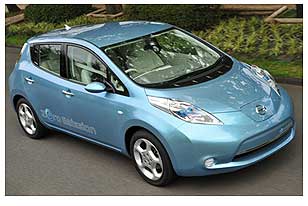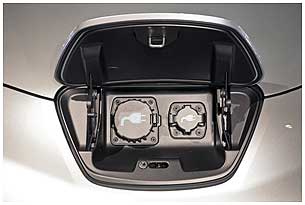By Paul Bindon
The current high price of gasoline, government incentives, and the emergence of improved battery technology are allowing the electric vehicle to become more accepted by the general public as a viable transportation option. Auto manufacturers are scrambling to bring to market their version of the electric car. Although the latest technology has made electric cars a green technology trend, they are not new.
Electric cars were very popular around the turn of the century. They were easy to operate: You simply had to turn on a switch and drive. Gasoline-powered cars were crank started until the invention of the electric starter in 1912. The complexity of operating a gasoline-powered car, coupled with the scarcity of gasoline, made electric cars a great option for in-city driving.

(1) The Baker electric car
Let’s fast forward to more recent history. The EV1 from General Motors was a fully functioning electric car that was available for lease from 1996 to 1999. The first generation of the EV1 was equipped with lead-acid batteries and had an 80-100 mile range. The second generation was upgraded to a more modern nickel metal hydride (NiMH) battery pack and enjoyed a range increase to 100-140 miles. These numbers are not much different from the currently available Nissan Leaf (16 years later). Sadly, the EV1 can no longer be found on the road; they were all recovered at the end of their leases and crushed, despite pleas by leasees who wanted to purchase the vehicles outright. For an in-depth look at why this happened, “Who Killed the Electric Car” is an interesting movie. “Revenge of the Electric Car,” produced by the same director, is premiering in film festivals around the country.

(2) The GM EV1 electric car

(3)…and the EV1 at lease end
During this time period, other manufacturers also produced a more limited production run of electric cars such as the Toyota RAV 4 and the fleet-only truck offerings from Ford and GM. The production of these cars was an attempt to meet the “zero emission” vehicle standards set by the California Air Resources Board. Some samples of these electric cars can still be found for sale at a premium price.

(4) Toyota RAV 4 EV
What is available for an electric car buyer today? If you would like to go into a car dealership and purchase a production electric car right now, your choices would be limited to two vehicles.
Tesla Roadster
The Tesla Roadster is a small two-seat vehicle that uses lithium-ion battery technology. It is the cheapest production vehicle and is equipped with body panels made entirely from carbon fiber for weight savings. The body is made by Lotus in England and is then sent for completion to the Tesla factory in California. It can do zero to 60 miles per hour in less than four seconds (super car territory) and has an EPA-reported range of 244 miles. The sticker price of more than $100,000 makes it a niche market vehicle, but driving it is great fun.

(5) Tesla Roadster
Disabling procedures differ from those of other vehicles on the road, as the Tesla is not equipped with a 12V battery. Power to operate computer systems comes from a power converter supplied by the high-voltage battery pack. Since the battery is behind the driver, access to the rear of the vehicle is necessary. Located on the right (passenger) side of the battery pack is a clearly marked wire loop cutting point.

There is also an orange service disconnect plug on the battery pack behind the driver. It is mounted fairly low and is not out in the open.

(7)Tesla Service Disconnect
Nissan Leaf:
The Nissan Leaf is the most recent electric car to come to market, and it has some real appeal for mainstream buyers. It is a four-door sedan that has an EPA estimated range of 73 miles. Its lithium-ion battery is expected to last more than 10 years. Two types of chargers can be used with the Leaf. The two plugs in front/center of the grille allow the 110V or 220V chargers to connect. The 110V charging option is reported to take 20 hours to fully charge a depleted battery and is intended to be a backup method of charging. The Leaf is designed to be charged by the primary charger, a 220V unit that is installed in your home; it takes approximately seven hours to charge a depleted battery. A 440V “quick charger” is in development and should take about 30 minutes to charge the vehicle when it becomes available. 
Nissan Leaf

(9) Charging Port (under the front Nissan badge)
Disabling procedures for the Leaf follow the more conventional method we have already seen for hybrid vehicles. It has a conventional 12V battery under the hood that powers the computers that control the SRS and high-voltage systems. The high-voltage battery service disconnect or “Orange Plug” is in the center of the rear seat floor area under an access hatch.
Plug-in hybrids
Consumers have a common concern about electric vehicles, referred to as “range anxiety.” What happens if you want to drive to a destination that is farther away than the capabilities of your electric car? You can plan a stop somewhere along the way for a vehicle charge, but it will take some time to top off the batteries. Most people are not yet willing to change their expectations regarding the use of their vehicles in this way.
Chevrolet Volt
Contrary to the early perception by many people, the Volt is not an EV. It is a plug-in hybrid. Although GM has spent a lot of effort to educate the public about its current green car offering, it is still often referred to as an electric car. The Volt uses a small internal combustion engine primarily as a generator. The electric motor drives the wheels. It can operate on battery power only for an EPA-rated 35 miles on a full charge. If your destination is farther away than 35 miles, the engine is started and will supply the electricity required, by a generator, to extend the Volt’s range for an EPA-rated 379 total miles.
Toyota Prius
The Prius has been available as a plug-in for some time. If you want a plug-in Prius, all you have to do is have it converted by one of several companies who specialize in this conversion. The City of Seattle has been using several of these vehicles. A lithium-ion battery is added to the spare tire area to allow the vehicle to run on electric power for a range of approximately 40 miles, after which normal hybrid operation resumes. The resulting fuel economy gains, up to 100 miles per gallon, are impressive. But the $10,000 to $12,000 cost of converting to plug-in is significant.
 (10) Example of a Prius with the Hymotion plug-in conversion.
(10) Example of a Prius with the Hymotion plug-in conversion.
The technology exists today for any NiMH type of hybrid to be converted to plug-in use with the addition of Li-Ion batteries. The costs involved make this option not feasible for most people.
Toyota has been developing a plug-in version of the Prius to be sold at your local dealership. The recent natural disaster in Japan, however, has hampered production efforts for these vehicles. The supply of vehicles is slowly increasing, but will be limited for some time.
EVs can be produced for varying amounts of range depending on the size of the battery used and the cost of the vehicle. A vehicle with a 100-mile range meets the needs of most drivers and also balances the cost of battery capability (range) with what people are willing to pay.
Neighborhood Electric Vehicles (NEVs)
Sometimes resembling golf carts, NEVs are a separate class of vehicle that differs from normal electric cars in several important ways. They do not need to meet crash testing standards because their on-road speed is limited and they are classified as “low speed vehicles” by the Department of Transportation. Some states have recently increased their speed restrictions and allow these vehicles to operate up to 35 miles per hour legally. The fact that these vehicles are not held to crash safety standards has raised some obvious concerns for the general public. Most of these vehicles are powered by lead-acid batteries to control costs. This also raises safety concerns because of the explosion and fire hazards that accompany this type of battery. Charging systems for these vehicles are normally 110V overnight chargers.
Emergency Response
Plug-in vehicles, whether they are EVs, plug-in hybrids, or NEVs, use grid electricity for charging purposes. Treat a plug-in type vehicle fire that ignites while being charged the same as a structure fire. Shut down the grid electricity whenever possible. EVs and plug-in hybrid vehicles have a very important thing in common with conventional hybrids: The high-voltage propulsion systems are controlled by a conventional 12V electrical system. All computers in vehicles run on 12V. It is essential to remember this when stabilizing the vehicle. Before performing any extrication procedure, disconnect the 12V battery. When the 12V battery is no longer connected, the high voltage will be contained within the HV battery. The SRS system and HID headlights will also be disabled.
As plug-in type vehicles become more commonplace, it is important to become familiar with the technology involved and how to safely disable it when responding to a motor vehicle accident. Battery technology is advancing rapidly and will soon be able to provide the performance consumers need to switch away from conventional transportation choices. More EV and plug-in hybrid vehicles are going to be on the market soon, as demand remains strong for vehicles that address the concerns of consumers regarding the increasing cost of fuel.
Paul Bindon joined MGS Tech in 2008 as a research specialist and on-site trainer and has completed extrication training at the Corona-X seminar. Paul is also an ASE Certified master auto technician with over 23 years experience in the automotive field. He has been employed with Lexus dealerships for the last 16 years, receiving both master diagnostic specialist and hybrid certification through factory training in the latest automotive technologies.

